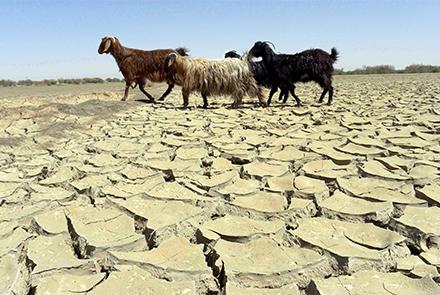The Ministry of Agriculture, Irrigation and Livestock (MAIL) said on Monday that this year’s drought has had a devasting effect on agriculture and has affected at least 66 percent of all livestock.
Officials at the ministry said that the livestock sector is seriously concerned about the situation and that there is a critical shortage of fodder.
The ministry’s spokesman Akbar Rustami said despite the provision of aid for livestock, the risk of malnutrition and death of these animals was a serious challenge.
“Undoubtedly, this year's drought has affected livestock, but we are trying to deliver animal feed for livestock and so far millions of Afghanis have been spent in this sector and we have more plans for this sector,” said Rustami.
This came after the Afghan government launched a $100 million appeal in mid-April through MAIL for immediate livestock protection for an initial two months of assistance for fodder support and an overall demand of $550 million for a 10 months fodder support throughout the 34 provinces of Afghanistan.
The ministry said large tracts of grazing land have been badly affected by the drought across the country and animals have little grass to feed on.
Meanwhile, the National Disaster Management Authority (ANDMA) says that the drought has affected an estimated fifteen million heads of livestock in the country.
“Recent droughts in many parts have had negative effects, especially in the livestock sector,” said Mohammad Omar Mohammadi, spokesman for the ANDMA.
According to information provided by MAIL, the country's livestock sector is currently estimated to be worth about $7 billion – which includes over 20 million goats and sheep.
A number of experts believe that the effects of this year's drought will cause severe damage to the sector.
In April, Reuters reported that Afghanistan faces the threat of serious drought this year after recording the lowest snowfall and rain in years over the winter.
Of the 34 provinces in the country, 20 recorded a serious shortfall in rain and snowfall during the winter season.
“This year drought has reached a level that we will have to announce an emergency in several parts of the country,” said Hashmat Khan Bahaduri, another ANDMA spokesman, at the time.
Bahaduri said funds would be allocated to mitigate the impact but that the country would have to import, or receive donations, to overcome food shortages.
According to Famine Early Warning Systems Network, a group set up by USAID to help planning for humanitarian crises, snowfall in Afghanistan’s last winter season was the lowest since 2002.
Snowmelt is an important source of water for crops and irrigation in a country where food is scarce for many households.
Relief Web also reported in April that Badghis, Balkh, Faryab, Jawzjan, Helmand, Nimroz, Uruzgan, Kunduz, Takhar, Herat, Ghor and Farah were are among the worst affected provinces.
The organization said the population in these affected provinces are most likely to need support in the areas of nutrition and food security, water and sanitation, emergency shelter and non-food items in the coming months.
In the 20 provinces most affected by the drought, nearly 15 million people rely on farming, livestock or labor opportunities in agriculture.
Of these, an estimated two million people will become severely food insecure due to the drought.

